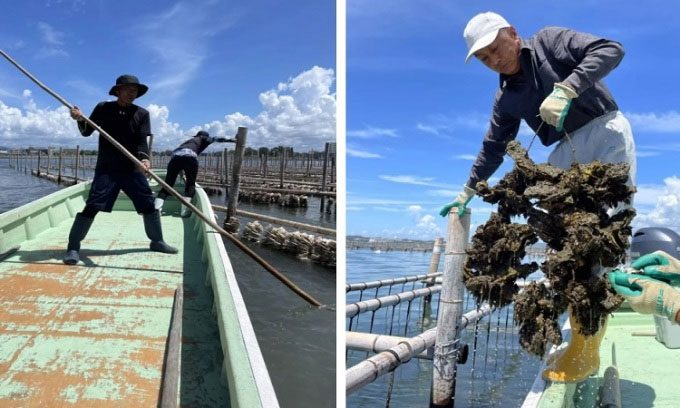The recent record rise in water temperatures has led Japanese fishermen to face significant losses as the aquatic species used in sushi have died en masse or migrated to distant waters.
Every year, as July approaches, Norio Terada and oyster farmers sink hundreds of beautiful shells on ropes below the surface of Lake Hamana. The small black larvae that attach to the shells will be harvested from the brackish water after about 18 months, emerging as mature oysters. However, first, they need to survive in an increasingly harsh environment. In recent years, rising temperatures have caused a decline in production, pushing fishermen across Japan into difficult circumstances, according to the Los Angeles Times.

Oyster farmers working at Lake Hamana in Maisaka, Japan. (Photo: LA Times).
“The oyster farming industry has a history of over 100 years. But this is the first time I’ve encountered such a large number of dead oysters,” Terada shared. A particularly poor harvest three years ago resulted in production dropping to just one-tenth of the usual amount.
The main threat is warming waters, which disrupt the growth process of oysters and many other aquatic species as oxygen levels decrease. The average global ocean surface temperature reached a record high in August 2023, according to the National Oceanic and Atmospheric Administration (NOAA). Heat waves at sea pushed temperatures in some areas close to 37.8 degrees Celsius this summer. Changes in sea temperature have also disrupted the migration patterns and behaviors of marine life, leading to more intense activity from coastal snapper in Maisaka during winter, preying on Terada’s nearly mature oysters.
Terada is not the only one struggling with dwindling yields. Four years ago, Japan was one of the largest fishing nations in the world, with an annual catch of over 12 million tons in the 1980s. However, Japan’s catch has gradually declined over the past decade, hitting a record low of 3.85 million tons in 2022, down 7.5% from the previous year.
Due to a preference for cooler climates, some species such as mackerel and flying squid have moved further out to sea, beyond the reach of Japanese fishermen, especially amid rising fuel prices. Species typically caught in southern Japan, like amberjack or striped mackerel, have made a reappearance in the north. Usually, these fish need to be transported south to more familiar areas for consumption.
Rising seafood prices are impacting both Japanese consumers and traders. In May, food inflation hit a 47-year high, with fish prices rising 14.8% compared to the previous year, far outpacing an 8.6% increase in meat prices. “The ecosystem’s response is changing. It has become very difficult to predict which species will increase,” said Shin-ichi Ito, a professor at the Ocean and Climate Research Institute of the University of Tokyo. “Fishermen can adapt. But the food industry finds it challenging to adjust as the majority of companies are quite small.”
In 2021, Japan’s fishing and aquaculture industry generated $9.5 billion in revenue. That year, the Ministry of Agriculture, Forestry and Fisheries planned to bring aquaculture production back to 4.44 million tons by 2030, the level seen in 2010, and promote the breeding of strategically important species such as grouper and amberjack. The ministry’s fisheries agency stated that they are also aiming to mitigate the impacts of climate change by promoting the electrification of fishing vessels, cultivating heat-tolerant species, and developing measures to help juvenile fish survive in harsher environments.
“The government needs to change the structure of the fishing industry based on the assumption that there will almost be no salmon or mackerel available for catch in the waters around Japan,” said Takahisa Yamamoto, assistant director for policy planning at the fisheries agency, referring to the two fish species that have seen the most significant declines in catch over the past decade. “As long as climate change continues, we cannot conceive of the best-case scenario.”
Changes in the natural environment are not restricted to temperature alone. Some fishermen complain about increasingly frequent red tide events, where blooms of phytoplankton can threaten marine life. Fluctuations in major ocean currents around Japan also affect water temperatures and the activities of local organisms. Others blame the decline in yields on overfishing or filtering systems that deprive the ocean of essential nutrients for marine life. There are many varied reasons and complex underwater food chains. Some researchers hesitate to conclude that global warming is the sole cause of reduced catches.
Meanwhile, fishermen are adopting their own measures to compensate for poor yields. A few years ago, Terada and many others began hanging nets on bamboo racks to deter snapper, a technique learned from nearby aquaculture towns. A few kilometers away, clam farmers are also experimenting with similar measures, suspending nets on poles in shallow waters. However, they found the material too prone to tearing, leaving the nets riddled with holes. This year, they switched to flat filament nets, covering juvenile clams collected around Lake Hamana.
On a scorching afternoon in August, 42-year-old fisherman Yusuke Kawai pulled in the nets and inspected the clams in his hands. Many were dead. The netting effectively kept snapper and sea slugs at bay. However, Kawai felt they had placed the clams in the water too late, exposing them to the afternoon heat before they could escape by burrowing into the sand. He estimated the water temperature was nearly 30 degrees Celsius at that time. A decade ago, clams in the lake were so plentiful that tourists would come to harvest them. Five years ago, clams still accounted for half of Kawai’s annual catch. But over the past two years, he has barely harvested anything and has had to supplement his income by catching mullet and cultivating seaweed.


















































